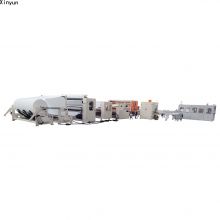Copyright © 2025 Fujian Xinyun Machinery Development Co.,Ltd. All rights reserved. Site Map
Toilet paper is among the most ubiquitous consumer items, yet its production involves an intricate, highly automated process. This guide explores how modern toilet paper making machines transform wood pulp or recycled fiber into the soft, perforated rolls found in households globally.
Virgin pulp: Wood chips cooked in digesters via chemical processes such as the Kraft method, separating lignin from cellulose.
Recycled pulp: Involves deinking using flotation and washing to remove inks and adhesives.
The refined pulp (almost 99.5% water) is sprayed onto a moving forming wire, allowing water to drain and fibers to interlock into a wet sheet. It traverses the press section, where rolling presses out additional moisture, and is then dried by steam-heated cylinders (e.g., a Yankee dryer) until moisture content drops to around 5%.

A vital step, creping, occurs as the hot, thin sheet is scraped from the dryer with a blade. This creates crinkles that enhance flexibility, absorbency, and softness — and cause the roll to dissolve when wet.
The dried, creped paper is wound into large parent rolls. Converting machines perform multiple critical functions:
Perforation: Precision blades (e.g., oblique or spiral types) punch tear lines for easy separation of sheets.
Embossing: Rollers imprint patterns to enhance aesthetics and tactile feel.
Core Insertion & Rewinding: The paper is wound around cardboard cores under controlled tension; log accumulators manage the flow to cutting machines.
The rolled logs are sliced into individual toilet paper rolls by a rotary cutting machine—capable of up to 70 cuts per minute—ensuring clean, consistent edges. Finally, these rolls move to automated packaging machines that wrap, bundle, and seal them hygienically before distribution.
Throughout production, Quality Control Systems (QCS) measure moisture, thickness, smoothness, basis weight, and other key metrics in real-time, ensuring consistent product quality. Modern lines also optimize energy efficiency, recycle water, and embrace eco-friendly fibers like bamboo, recycled pulp, and bagasse.
Leading systems, known as non-stop toilet paper machines, integrate winding, cutting, embossing, perforating, and packaging to operate continuously with minimal supervision. Embedded PLC control systems, touchscreen HMIs, and remote monitoring further enhance efficiency and reduce labor interventions .
At Fujian Xinyun Machinery Development Co., Ltd. in Quanzhou, China, we design and manufacture complete toilet paper production lines tailored for high efficiency, consistency, and cost-effectiveness. With 15+ years of experience, we supply:
Parent roll machines (widths 1.2–2.8 m, customizable)
Perforating, embossing, cutting machines
Rewinding units, core-making equipment
Automated packaging and complete converting lines
Our in-house processing ensures quality control and fast delivery. Our energy-saving, eco-aware designs have earned praise in South America, Africa, the Middle East, and Europe. We offer turnkey services—shipment, installation, and operator training—so you can start production smoothly and confidently.
From pulp preparation to packaging, modern toilet paper making machines harness engineering precision, automation, and sustainability. These systems transform raw materials into hygienic, consumer-ready rolls with remarkable speed and consistency.
Whether you're launching a new production operation or upgrading an existing line, Fujian Xinyun Machinery offers expert engineering and robust solutions. Contact us today to discuss your needs and explore how our machines can help you achieve efficiency, quality, and a competitive edge.
By continuing to use the site you agree to our privacy policy.